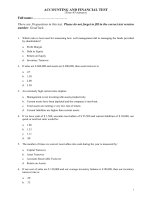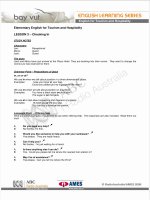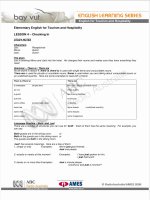- Trang chủ >>
- THPT Quốc Gia >>
- Hóa
Levers, gears, and pulleys
Bạn đang xem bản rút gọn của tài liệu. Xem và tải ngay bản đầy đủ của tài liệu tại đây (3.58 MB, 10 trang )
Genre
Nonfiction
Comprehension Skill
Cause and Effect
Text Features
• Captions
• Diagram
• Glossary
Science Content
Simple Machines
Scott Foresman Science 6.16
ISBN 0-328-14017-1
ì<(sk$m)=beabhg< +^-Ä-U-Ä-U
Vocabulary
Extended Vocabulary
compound machine
effort force
fulcrum
load
machine
simple machine
work
calipers
cranks
interconnected
intricate
modified
oscillatory
spur gear
Picture Credits
Every effort has been made to secure permission and provide appropriate credit for photographic material.
The publisher deeply regrets any omission and pledges to correct errors called to its attention in subsequent editions.
Photo locators denoted as follows: Top (T), Center (C), Bottom (B), Left (L), Right (R), Background (Bkgd).
Opener: ©Michael Melford/Getty Images; 5 ©Eric Millette/Index Stock Imagery; 7 (BL) Getty Images;
11 (TR) ©Michael Melford/Getty Images.
Unless otherwise acknowledged, all photographs are the copyright © of Dorling Kindersley, a division of Pearson.
ISBN: 0-328-14017-1
Copyright © Pearson Education, Inc. All Rights Reserved. Printed in the United States of America.
This publication is protected by Copyright, and permission should be obtained from the publisher prior to any
prohibited reproduction, storage in a retrieval system, or transmission in any form by any means, electronic,
mechanical, photocopying, recording, or likewise. For information regarding permission(s), write to
Permissions Department, Scott Foresman, 1900 East Lake Avenue, Glenview, Illinois 60025.
3 4 5 6 7 8 9 10 V010 13 12 11 10 09 08 07 06 05
What did you learn?
1. What are the six simple machines?
2. What are the three components that help
differentiate the types of levers?
3. How are gears related to simple machines?
4.
Most machines are
compound machines that are made up of
simple machines. Write to explain how a
single simple machine works.
5.
Cause and Effect What would be the
effect of using an inclined plane (ramp) to
byfrom
Alma
Ransford
move a heavy load
a lower
level to a
higher level?
What You Already Know
The use of force to move an object a
certain distance is called work. The
formula to express how much work has
been done is: work = force × distance.
Work is measured in joules. A joule is
the amount of work done when one
Newton of force is exerted over a
distance of one meter. It’s important to
know how much effort, or applied force,
needs to be put into work. Inventors are
always trying to find ways to make tasks
and work easier. They do this by finding
ways to decrease the effort force needed
to do work.
Today many people use machines
to do work. Some are compound
machines that have many parts. But many
machines are simple machines that have
only one or two moving parts, if any.
Knives, scissors, staplers, and doorknobs
are all simple machines.
Simple machines are very common. Most of them have one
movable part. All of them fall into one of the following groups:
lever, inclined plane, wedge, screw, wheel and axle, or pulley.
Within each of these groups, there are many types.
Pulleys can be either fixed or movable. Levers fall into
three categories based on the position and role of the
fulcrum, load, and effort force.
Machines change the distance over which a force
is exerted and the effort force needed to do work.
Another important thing for inventors of
machines to consider is friction. Inventors try
to reduce the amount of energy lost by reducing
friction between the moving parts of the
machine they are designing.
Understanding simple machines helps
you understand compound machines.
They may have thousands of parts,
but many of those parts are actually
simple machines. Wheelbarrows,
bicycles, and sailboats are some
examples of compound
machines made up of
many simple machines.
examples of
simple machines
2
3
Simple Machines
Many people think that the word machine describes a
loud, noisy piece of equipment. In science, a machine is any
device that helps people do work.
Machines may require you to use a lot of force. For
example, it takes a lot of force to push a wheelbarrow full
of soil and rocks, but it is still a lot easier than moving rocks
by hand!
A baseball bat is another familiar simple machine. It
makes it much easier to hit a baseball or change its direction
of motion. Most people can hit a baseball with a bat farther
than they can throw one. It still takes some effort force to hit
a baseball, but the bat helps people hit the ball with more
force than they could without it.
If you push a wheelbarrow
up a ramp, you have
to push over a greater
distance, but your job
is easier!
4
Lombard Street in San Francisco
goes up a very steep hill. A series of
inclined planes were built back and
forth across the slope. This allows
cars to travel up and down the hill
more easily.
Inclined Plane
An inclined plane is one
type of simple machine. It is also
known as a ramp. You probably
could not lift a piano one meter
above the floor by yourself. But if
you used a ramp you could.
Inclined planes are very
useful as ramps that help move a
load from a low place to a higher
place. Moving a load up a ramp
takes less effort force than lifting
the load straight up. But the load
actually has to travel farther as it
goes up the ramp than it would if
it went straight up. Although it is
easier to use the ramp, the same
amount of work still gets done.
If you multiply the small force
and large distance of using the ramp, you get the same number as
when you multiply the large force and small distance of lifting the
load straight up.
Inclined planes are also used in the construction of roads to
make driving on hills easier. Lombard Street in San Francisco is a
good example. Engineers used several inclined planes to make it
easier for cars to travel on the steep hill.
5
The Screw
The Wedge
A screw is one example of a modified inclined plane. It is an
inclined plane that is wound around a cylinder to form a spiral
with a sharp tip. Its ridges are called threads. Screws are often
used to tighten or fasten two objects. The lids of many jars are
actually screws. You twist the lid to tighten it. You
could push the lid onto the jar, but the screw lets you
fasten it securely with much less force. But you have
to exert that force over a larger distance.
Nails and screws are both used in construction
to fasten wood. It takes a lot of force to drive a nail
into a wall. It takes much less force to twist a screw
into a wall, but you must exert that force over a
larger distance.
Another variation of the inclined
plane is the wedge. It is made up of
one or two inclined planes, or sloped
surfaces. These sloped surfaces form
wedge
a point.
Wedges are often used to split
materials apart. A force applied to
the wider end of the wedge drives
the point forward. It focuses the
effort force on a narrow area. The
slanted sides of the wedge direct
some of the force outward, pushing
the material apart.
From ax to steak knife, just about
all machines that cut use wedges. The
longer and thinner a wedge used for
The hammer supplies the
cutting is, the less effort is required.
effort force to push this
Sharp knives are safer and easier to
wedge and split the wood.
use, since less force needs to be
applied to them in order to cut through something. Sharp tools
such as chisels and needles are also made of wedges. Snowplows
and shovels are other examples of tools using wedges.
A screw is a kind of inclined
plane that is wrapped around
a cylinder and forms a spiral.
Archimedes’ screw is a simple
machine invented around 300 B.C.
It was used to lift water.
hammer
An ax is a wedge, a type
of inclined plane.
6
7
Levers
Another simple machine is the lever. It is made up of a bar
that rests on top of a support called a fulcrum. A load, or object
to be moved, sits at one end of the lever. To move the load, force
needs to be applied to the opposite end. This is applied force, or
effort force. The screwdriver below is being used as a lever to
open the can of paint. The edge of the paint can is used as a
fulcrum. The tip of the screwdriver is under the lid of the paint
can. The stuck lid is the load. If a person pushes down on the
screwdriver, the lid will be pushed up and off the can.
A lever’s fulcrum can be located at any point along the lever.
In different types of levers, the load and the fulcrum are located
in different positions. A fulcrum that is closer to the load needs
less force to move the load but won’t lift it as high. A fulcrum
closer to the effort force needs more force to be applied, but the
load will be lifted higher.
There are three kinds of levers. First-class levers have the
fulcrum in the middle, the effort force at one end, and the load
at the other end. Second-class levers have the effort force at one
end, the fulcrum at the other end, and the load in the middle. A
wheelbarrow is a second-class lever. Third-class levers have
the fulcrum at one end, the load at the other end, and
the effort force in the middle. Hockey sticks,
baseball bats, and fishing poles are actually
third-class levers. Many common
tools use two identical levers
that share a fulcrum.
Scissors, pliers,
load
nutcrackers, and
fulcrum
chopsticks are actually
pairs of levers.
effort
Pliers used to crack a nut are
a pair of first-class levers.
This screwdriver is used as a lever
to push the paint can’s lid up.
fulcrum
A nutcracker is a pair of
second-class levers.
load
effort
load
fulcrum
fulcrum
Chopsticks are used here as
a pair of third-class levers.
load
effort
8
9
Wheel and Axle
Gears
A wheel and axle is another simple machine. It may have
been one of the earliest simple machines and has been in use
since around 3,600 B.C.
A wheel and axle is really a lever that rotates through a
complete, 360˚ circle. The axle is attached to the center of the
wheel. The wheel turns in a larger circle than the axle does. That
means the outside of the wheel travels a much greater distance
than the axle. The smaller turn of the axle is powerful, though.
A wheel and axle can increase force or increase the distance over
which a force acts.
When you pedal a bike your foot moves in a large circle,
but the axle turns in a small circle. The axle turns with much
more force than the pedal turns, but the pedal moves a much
longer distance.
A gear is a modified
wheel and axle. Gears are
important parts of many
mechanical devices. The
wheels of gears have “teeth,”
or pegs, around their outer
Often, many individual gears are
edge that fit into other gears.
used at once to make large groups
In a pair of gears, the larger
of interconnected gears.
one rotates more slowly
than the smaller one. But the larger one moves with greater force.
If the gears are the same size, they both turn at the same speed. In
a series of interconnected gears, each gear changes the direction of
the rotation made by the gear before it.
Spur gears are the most common type of gears. They have
straight teeth that stick out from their edges. The gears in bicycles
are spur gears connected by a chain.
One turn of the small
front gear causes less
than one turn of the
larger rear gear. The
bicycle doesn’t move
very fast, but the pedals
can be turned without
using much force.
chain
pedal
axle
10
One turn of the large front
gear causes several turns
of the small rear gear.
This makes the bicycle go
faster, but requires a lot of
force on the pedals.
11
Pulleys
axle with
grooved
wheel
A pulley is a grooved wheel with a
effort
chain or rope around it. A load is
attached to one end of the rope, and
effort force is applied to the other end.
Pulleys are used to raise flags, sails, and
curtains. They open garage doors. Can
you think of other uses for pulleys?
Pulleys are either fixed or movable.
A fixed pulley will stay in position as its
load
wheel spins. You pull down on one end
of a fixed pulley rope to lift up the load
on the other end. This changes the
direction of the force, but it doesn’t
lessen the effort force needed. Pulling
fixed pulley
down on the rope will result in the
load moving upward.
A movable pulley is attached to the
item being moved. As force is applied to the load, the pulley
moves with it. This type of pulley increases force, but the force
has to be applied over a greater distance. If the pulley allows
you to lift with twice the normal force, you must pull the rope
twice as far.
Two or more pulleys can be used together as a system. This
is called the block and tackle system. Each pulley reduces the
amount of effort required to lift the load. A block and tackle
with a lot of pulleys could help lift a heavy load, as shown in
the photograph to the right.
12
To lift cargo, a block and
tackle pulley is used with
movable and fixed pulleys.
13
Combining Machines
It is the combined, or compound, machine that most people
think of when they hear the word machine. Automobiles,
excavators, food processors, elevators, and pencil
sharpeners are just a few of the compound machines that
you probably see or use on a daily basis. A compound
machine is a machine that is made up of two or more
simple machines.
A bicycle is a compound machine you
probably see every day. The tires, pedals, and
handlebars are examples of a wheel and axle.
The brakes use levers both where your
hands clutch them and as the calipers
that squeeze the bike’s wheels. The
cranks that connect the pedals to the
front gears are levers. The gear system
on many bikes includes a pulley as well
as multiple gears.
Many compound machines, such as a train, have thousands
of parts. Even the biggest of these machines, though, is made up
of simple machines. Each simple machine does a different type
of job. When simple machines are combined in a compound
machine, that machine can perform complex tasks.
Combining the different types of motion that simple
machines produce—linear (in a line), rotary (in a circle), and
oscillatory (back and forth)—creates an effective compound
machine. Engineers and inventors tinker with these elements
as they work to develop better compound machines.
Compound machines have been around for a long time.
Recently it was discovered that a compound
machine must have existed in China about
2,500 years ago. Scientists have discovered
lever
that grooves in ancient jade objects are far
too intricate, elaborate, and perfectly shaped
to have been made by hand or by simple
machines. They don’t know what the machine
that made them looked like, but they do believe
that it existed.
A bicycle combines
simple machines.
gear
wheel
and axle
14
15
Vocabulary
Glossary
Extended Vocabulary
compound machine
calipers
effort force
cranks
fulcrum
interconnected
calipers
parts of a bicycle’s brake system that squeeze
load
intricate
the wheels
machine
modified
simple machine
oscillatory
cranks
parts of a bicycle that connect the pedals
work
spur gear
to the front gears
interconnected
having parts that are joined together
intricate
of complicated or very elaborate nature
modified
changed to improve or simplify
oscillatory
having a back-and-forth motion
spur gear
a gear with straight teeth sticking out from
its edges
Picture Credits
Every effort has been made to secure permission and provide appropriate credit for photographic material.
The publisher deeply regrets any omission and pledges to correct errors called to its attention in subsequent editions.
Photo locators denoted as follows: Top (T), Center (C), Bottom (B), Left (L), Right (R), Background (Bkgd).
Opener: ©Michael Melford/Getty Images; 5 ©Eric Millette/Index Stock Imagery; 7 (BL) Getty Images;
11 (TR) ©Michael Melford/Getty Images.
Unless otherwise acknowledged, all photographs are the copyright © of Dorling Kindersley, a division of Pearson.
ISBN: 0-328-14017-1
Copyright © Pearson Education, Inc. All Rights Reserved. Printed in the United States of America.
This publication is protected by Copyright, and permission should be obtained from the publisher prior to any
prohibited reproduction, storage in a retrieval system, or transmission in any form by any means, electronic,
mechanical, photocopying, recording, or likewise. For information regarding permission(s), write to
Permissions Department, Scott Foresman, 1900 East Lake Avenue, Glenview, Illinois 60025.
3 4 5 6 7 8 9 10 V010 13 12 11 10 09 08 07 06 05
16
What did you learn?
1. What are the six simple machines?
2. What are the three components that help
differentiate the types of levers?
3. How are gears related to simple machines?
4.
Most machines are
compound machines that are made up of
simple machines. Write to explain how a
single simple machine works.
5.
Cause and Effect What would be the
effect of using an inclined plane (ramp) to
move a heavy load from a lower level to a
higher level?









